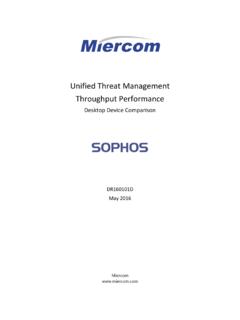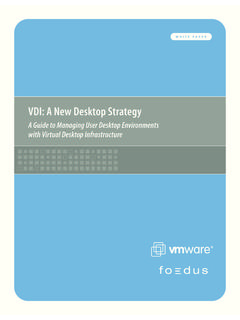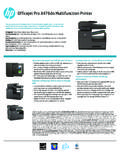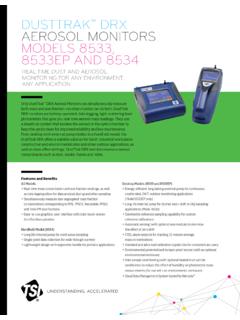Transcription of What is a thin client - Compaq
1 HP Compaq t5000 thin client Series Simple, dependable, manageable, and more secure solutions for your business environmentHP Compaq t5000 thin client Series 2 Executive what is a thin client ?..3 Server-based computing Consolidated client Infrastructure (CCI)..4 Virtual Desktop Infrastructure (VDI)..4 what s in a thin client ? ..5 Who needs thin clients ?..6 HP Compaq thin what s special about these products?..6 HP Compaq t5135 thin HP Compaq t5530 thin HP Compaq t5720 thin HP Compaq t5725 thin thin client PCI Expansion Altiris Deployment HP OpenView client Configuration Feature comparison ..17 Implementing an SBC The Microsoft The Linux The Citrix The HP The HP Choosing a Blade Choosing a HP Lifecycle HP Care Pack HP quality and HP compatibility/industry Appendix: Sample Business application Citrix portal Wireless For more Compaq t5000 thin client Series 3 HP helps you gain a competitive edge and simplify IT management by providing affordable thin clients with enhanced security features and Microsoft Windows and Linux operating systems for your server-based or blade PC computing solutions.
2 HP thin clients lead the way with proven business technology for maximum security and lower ownership costs through reliable and consistent products that are easy to buy, deploy, and manage for outstanding investment protection. Executive summary More and more organizations are recognizing the benefits of server-based computing (SBC) in conjunction with thin clients . thin clients deliver a desktop experience in work environments where end users have a well-defined set of tasks, such as general office applications in medical, financial, educational, government, manufacturing, distribution, or call center environments. Above all, they provide you with: Fast, convenient access to applications Rapid, centralized deployment of new applications Controlled, secure environment with no removable media, helping reduce the risk of viruses and product or data theft Simplified client architecture and reduced hardware maintenance costs Server utilization optimized by load-balancing features that automatically route user sessions to the server with the lightest load Improved, simplified manageability that reduces the workload for IT staff Enhanced security and backup Software from Microsoft and Citrix that delivers an ideal SBC solution This document helps you evaluate HP s thin client offerings, including key features and benefits.
3 In addition, it offers an overview of SBC and SBC components, and provides sample scenarios showing how thin clients can meet various business needs. what is a thin client ? A thin client is a computing device without a hard drive, which displays data and applications from remotely located servers, blade PCs, or virtual desktops. There are three major models of thin client computing, discussed on the following pages. Server-based computing model In the traditional server-based computing model, the thin client runs the user interface and transmits the mouse clicks and keyboard data to a server. User applications run on the server, and the video data is sent back to the client for display. In this computing model, thin clients are typically utilized as part of a Citrix Presentation Server or Microsoft Terminal Services deployment. Many companies choose server-based computing to centralize application deployment and database information, or to deploy Web portals.
4 thin clients can also be used to access the Internet through a browser, or to replace older devices commonly referred to as green screen terminals. Offering the look and feel of a regular Microsoft Windows PC, thin clients allow businesses to centralize computing power, storage, applications, and data on servers running in a data Compaq t5000 thin client Series 4 Consolidated client Infrastructure (CCI) 1 thin clients are also an important component of a Consolidated client Infrastructure (CCI) solution, an entirely new computing model being introduced by HP. The Consolidated client Infrastructure (CCI) solution centralizes desktop computing and storage resources into easily managed, highly secure data centers, while providing end users with the convenience and familiarity of a traditional desktop environment. It provides a dynamic workplace solution that may dramatically lower desktop total cost of ownership (TCO) while raising levels of security, service quality, and ease of management.
5 CCI is an example of HP virtualization solutions solutions that enable an adaptive enterprise where business and IT are synchronized to capitalize on change. Leveraging combined product and services offerings from HP, CCI is a three-tiered architecture that consists of: An access tier using thin clients A compute tier with racks of blade PCs inside a data center A resource tier made up of a storage pool, network printers, application servers, and other networked resources, also inside the data center With CCI, end users access their applications and data in a customized environment just as they do today. The difference is that users work on a thin client and establish a one-to-one connection with dynamically allocated blade PCs and centralized storage. Individual desktop images and data are stored and controlled in an IT infrastructure in the data center. Virtual Desktop Infrastructure (VDI) In HP s Virtual Desktop Infrastructure (VDI) solution, end-user PCs are replaced by HP thin clients , reducing the need for desktop support resources.
6 High reliability servers, either HP BladeSystem or ProLiant, provide the backbone of the solution, with an optional HP SAN or local storage component. Figure 1. Demonstration of VDI 1 Not available in all Compaq t5000 thin client Series 5 A remote connection protocol enables the user to retrieve a desktop for use on a local device. The end user connects to a virtual machine to retrieve the desktop, which can be controlled by policies. Connection broker software can be used to ensure service continuity and a customized environment. The virtualization software layer provides the many-to-one desktop-to-server relationship, and includes HP partners such as VMware, Microsoft Virtual Server (MSVS), and Citrix. VMware and MSVS are virtualization technologies that house guest operating systems and applications in individual virtual machines on the server. Citrix can be used in the traditional terminal services environment, or with their new desktop broker product.
7 With HP s VDI, end users access their applications and data in a customized environment just as they do today. The difference is users work on a thin client and establish a many-to-one connection with dynamically allocated blade PCs and centralized storage. Individual desktop images and data are stored and controlled in an IT infrastructure in the data center. what s in a thin client ? A basic thin client consists of a processor, flash memory for storing the embedded operating system, local RAM, a network adapter, and standard input/output for the display and other select peripherals. HP thin clients have no moving parts, offering higher reliability than a PC, lower ownership costs, enhanced security, and extended product life. These small, robust devices consume significantly less energy than a desktop PC, emit less heat into your office spaces, have a much smaller footprint than a desktop, and are practically silent. thin clients are based on the Microsoft Windows Embedded family of operating systems which includes Microsoft Windows CE and Microsoft Windows XP Embedded and the Linux operating system.
8 These devices are key components in server-based computing solutions where applications are deployed through the Terminal Services functionality of the Microsoft Windows 2003 Server family, through Citrix Presentation Server, Web-based services, or blade PCs. thin clients and power applications thin clients are not recommended for some applications, such as those involving workers who need powerful local processing and significant storage. These workers typically include engineers, graphic artists, multimedia developers, and Compaq t5000 thin client Series 6 Who needs thin clients ? thin clients can meet many business needs: Businesses where end users have a well-defined set of tasks, such as general office applications in medical, financial, educational, government, manufacturing, distribution, or call center environments. Users can run a wide range of office software such as Microsoft Word, Excel, and PowerPoint, or unique line-of-business applications.
9 Businesses that require a highly available network of computers connected to a centralized server running mission-critical applications can greatly benefit from the reliability of thin clients . Hospitals, insurance agencies, airline reservation centers, and hotels are typical businesses that fall into this category. Businesses with departments that carry out highly standardized computing tasks, such as sales or service call centers, data entry departments, or technical support desks, may realize substantial cost savings by deploying thin clients rather than desktop PCs. The computing power and flexibility of a desktop PC are often unnecessary and potentially undesirable in this environment users may load local applications, reconfigure, or otherwise tamper with the integrity of a desktop PC. Educational institutions and similar organizations typically need more computing resources on an ever-shrinking budget. Universities and schools with under-resourced IT departments must keep hundreds or thousands of computers up and running with the latest software, despite supporting multiple users per machine.
10 thin clients can meet these challenges in two ways: Firstly, with their solid construction and lack of moving parts, thin clients are designed to withstand heavy usage. Secondly, because applications and storage usually reside on the server, the latest versions are always available to every user. Businesses using dumb terminals can upgrade to thin clients to offer a more robust platform that can handle e-mail programs (such as Microsoft Outlook 2003) and common business applications (such as Microsoft Word or Excel). The HP Compaq t5000 thin client Series offers optional expansion capabilities through an external MultiBay that can accept a hard drive, diskette drive, or CD-ROM drive. Terminal emulation gives thin clients access to legacy database information. IT managers at Fortune 1000 businesses which have aggressive cost-cutting agendas are challenged to do more with less on a daily basis. thin clients typically promote cost savings and simplify IT tasks by allowing network administrators to update software remotely rather than deploy it repeatedly at the desktop.





